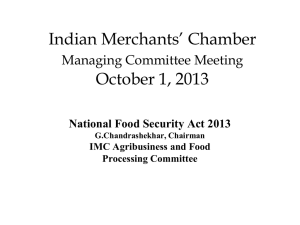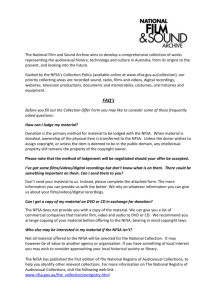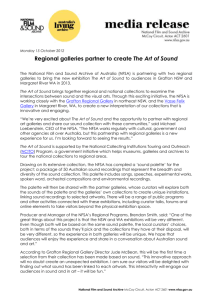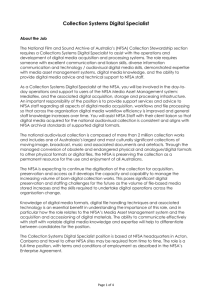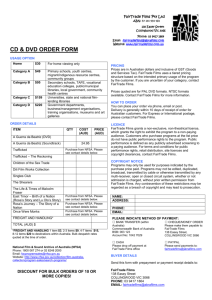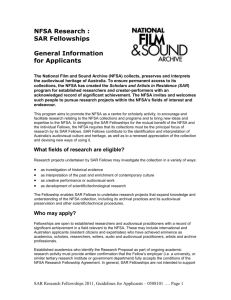NFSAeconomicreport
advertisement
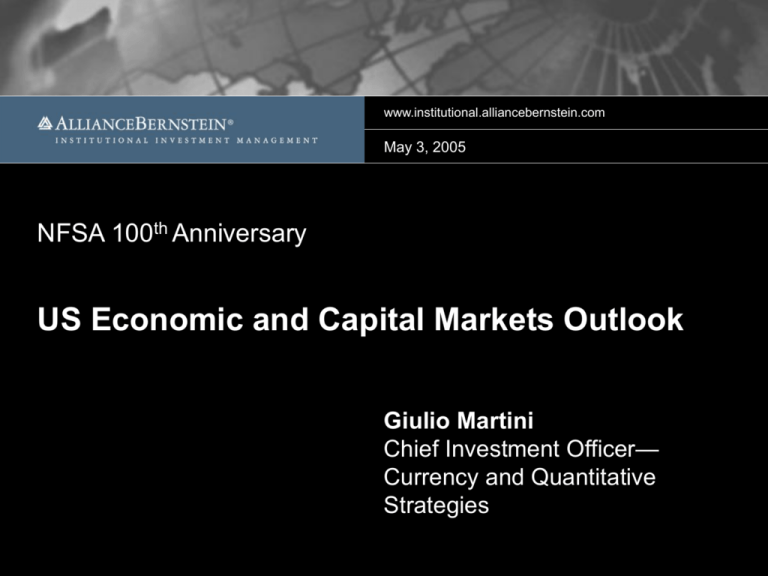
www.institutional.alliancebernstein.com May 3, 2005 NFSA 100th Anniversary US Economic and Capital Markets Outlook Giulio Martini Chief Investment Officer— Currency and Quantitative Strategies Recent US Economic Momentum Is Sustainable Liquidity* Flows vs. Real GDP Growth (YoY % chg) 10 Liquidity Flows 8 6 4 2 0 (2) (4) Real GDP Growth NFSA_ Capital Markets (6) 72 74 76 78 80 82 84 86 88 90 92 94 96 98 00 02 04 *Liquidity is a measure of real money growth, growth in business and consumer credit, growth in short-term liquid assets, foreign purchases of US securities, net cash flow into bond and stock funds Source: Bureau of Economic Analysis, Haver Analytics and Alliance Capital Fixed Income 2 Inventory Rebuilding Still Lags Final Demand Real Final Sales vs. Real Inventory Positions (YoY chg) 10% 8% Final Sales 6% 4% Inventory Positions 2% 0% (2)% NFSA_ Capital Markets (4)% 60 65 70 75 80 Source: Bureau of Economic Analysis, Haver Analytics and Alliance Capital Fixed Income 3 85 90 95 00 Investment Is Key Driver of Economic Growth 2004 Real GDP Growth Equipment and Software (9.8)% 14.5% Imports 6.5% Residential Exports 5.9% Real GDP 3.9% Consumption 3.8% Inventories NFSA_ Capital Markets Government Structures Source: Bureau of Economic Analysis, Haver Analytics and Alliance Capital Fixed Income 4 3.0% 1.6% (0.0)% Nonresidential Construction Usually Rises Steadily Index 160 140 Average of 5 expansions 120 100 80 1991 NFSA_ Capital Markets 60 0 2 4 6 8 10 12 Quarters from Trough Source: US Department of Commerce, Haver Analytics and AllianceBernstein 5 14 16 18 20 1991 Recovery Was Weaker and More Gradual Index 160 140 Average of 5 expansions 120 100 1991 80 1991 NFSA_ Capital Markets 60 0 2 4 6 8 10 12 Quarters from Trough Source: US Department of Commerce, Haver Analytics and AllianceBernstein 6 14 16 18 20 Current Recovery Very Modest Index 160 140 Average of 5 expansions 120 100 1991 80 Current Expansion NFSA_ Capital Markets 60 0 2 4 6 8 10 12 Quarters from Trough Source: US Department of Commerce, Haver Analytics and AllianceBernstein 7 14 16 18 20 Sprinklers Defy Construction Trend Annualized Growth: 1980–2004 4.0% (0.3)% NFSA_ Capital Markets Nonresidential Construction (Infation-Adjusted) 8 Sprinklers Employment and Income Trends Are Improving Payroll and Household Employment (Year-over-Year Change) Jobs (000s) 5,000 10% Payroll Employment 8% 3,000 7% 2,000 6% 0 5% Household Employment (1,000) 4% 3% Disposable Income 2% (2,000) NFSA_ Capital Markets Wage & Salary Income 9% 4,000 1,000 1% (3,000) 0% 91 93 95 97 99 01 03 05 Source: Bureau of Economic Analysis, Bureau of Labor Statistics and Haver Analytics 9 Disposable Income vs. Wages (Year-over-Year Change) 91 93 95 97 99 01 03 Personal Saving at All-Time Low, But Wealth at Record Levels Personal Saving Rate Household Net Worth (%) ($ Trillions) 50 9 8 45 7 6 40 5 35 4 30 3 25 NFSA_ Capital Markets 2 10 20 1 0 15 90 92 94 96 98 00 02 04 Source: Bureau of Economic Analysis, Federal Reserve Board and Haver Analytics 90 92 94 96 98 00 02 04 Housing Market Supported By Strong Fundamentals Home Sales and Affordability (000s) 7,000 Housing Affordability (right scale) 6,000 Rates vs. Prices Index (%) 160 18 140 16 120 5,000 100 4,000 3,000 NFSA_ Capital Markets 1,000 11 House Price Index (YoY % chg) 12 10 80 2,000 14 Mortgage Rate 60 Existing-Home Sales (left scale) 0 75 79 83 87 91 95 99 03 8 6 40 4 20 2 0 0 76 79 82 85 88 91 94 97 00 03 Source: Federal Housing Finance Board, Office of Housing Enterprise Oversight, National Association of Realtors, Haver Analytics and Alliance Capital Fixed Income Housing Starts Are Strong and Inventories Are Low Month’s Supply of New Homes at Current Sales Rate Housing Starts Units (Thousand) 2,300 January 2005 2,100 1,900 Ratio 12 10 1,700 8 1,500 1,300 6 1,100 4 900 NFSA_ Capital Markets 2 12 700 0 500 80 83 86 89 92 95 98 01 04 Source: Census Bureau and Haver Analytics 75 78 81 84 87 90 93 96 99 02 War Chest of Free Cash Flow; Bright Capital Spending Outlook Net Cash Flow vs. Business Investment in Equipment and Software ($ Billions) 1,400 Ratio of Free Cash Flow* to Capital Spending Ratio 1.4 Cash Flow 1,200 $287 Billion WOW!! 1,000 1.2 1.0 0.8 800 Investment 0.6 600 NFSA_ Capital Markets 0.4 13 400 0.2 200 0.0 (0.2) 0 80 84 88 92 96 00 04 *Three-year sum. Source: Bureau of Economic Analysis, Haver Analytics and Alliance Capital Fixed Income 60 68 76 84 92 00 Strong Capex Cycle Is Underway, and It’s Broad Based 2004 Business Spending on Equipment and Software (Year-over-Year Percent Change) 12-Month Dollar Change in Order Backlogs: February 2005 ($ Billions) 25.5% Computers $14.5 Other Equipment Software NFSA_ Capital Markets Industrial 14 Other Technology $14.0 20.1% Transportation Total $14.8 14.6% 14.5% 13.1% 10.6% 8.1% Metals & Machinery Source: Census Bureau, Bureau of Economic Analysis, Haver Analytics and Alliance Capital Fixed Income Technology Transportation Equipment Trade Deficit Is Large and Structural in Nature Imports As a Percent of Domestic Shipments Trade Deficit ($ Billions) 0 (%) 30 (100) 25 (200) (300) 20 (400) (500) 15 NFSA_ Capital Markets (600) 15 (700) 10 80 83 86 89 92 95 98 01 04 Source: Department of Commerce, Haver Analytics and Alliance Capital Fixed Income 1992 1995 1997 2002 2004 US Runs a Deficit in Every Product Category With Every Region 2004 US Trade Deficit Composition By Product Autos 22% Petroleum 25% Industrial Supplies 7% Miscellaneous 2% Capital Goods 2% Agricultural Goods 1% NFSA_ Capital Markets Consumer Goods 41% 16 Through November 2004 *Includes Venezuela and Indonesia. Source: Department of Commerce By Region Latin North America America 6% OPEC* 11% 17% Other 5% Pacific Rim 44% Western Europe 17% US Relies on Foreign Capital To Fund Its Investment Needs Current Account Balance As a Percent of GDP Savings and Investment as a Percent of GDP (%) 1 (%) 0 21 (1) 20 22 Investment 19 (2) 18 (3) 17 (4) 16 Current Account Imbalance Savings 15 (5) 14 NFSA_ Capital Markets (6) 17 13 (7) 12 90 92 94 96 98 00 02 04 Source: International Monetary Fund Haver Analytics and Alliance Capital Fixed Income 98 99 00 01 02 03 04 F Foreign Capital Flows into US Are Strong, Especially From Asia Foreign Purchases of US Financial Assets (4-Quarter Moving Average) ($ Billions) 700 Savings and Investment of Newly Industrialized Asian Economies as a Percent of GDP (%) 34 Total 600 Savings 32 500 30 400 300 28 Private 200 26 Investment NFSA_ Capital Markets 100 18 Official 0 (100) 24 22 94 96 98 Source: International Monetary Fund 00 02 04 98 99 00 01 02 03 04F Foreigners Have Lost Interest in US Equity Investments… Plant, Equipment, etc. $321 Bil. Stocks NFSA_ Capital Markets $194 Bil. 19 $163 Bil. $33 Bil. 2000 Source: Federal Reserve Board Flow of Funds 2004 …and Have Turned to Bonds Fixed Income $1,019 Bil. Fed Funds & $233 Other $133 Agency Plant, Equipment, etc. $321 Bil. $282 Corporate Stocks NFSA_ Capital Markets $194 Bil. 20 $163 Bil. $371 Government $33 Bil. 2000 Source: Federal Reserve Board Flow of Funds 2004 Foreign Ownership of US Financial Assets Growing US Treasury Bonds Fed Funds (Overnight Liquidity) US Corporate Bonds Owned by Foreigners 11% 24% NFSA_ Capital Markets 42% December 2004 Source: Federal Reserve Board Stocks 46% Real-Dollar Exchange Rate Still Above Prior Lows Real Trade-Weighted Dollar Index Mar 73=100 130 120 110 100 90 NFSA_ Capital Markets 80 22 87 83 76 70 73 77 Through March 31, 2005 Source: Federal Reserve Board and Haver Analytics 81 85 89 93 97 01 05 Growth in Oil Demand Met Largely by Former Soviet Union (FSU) Sources of New Supply (Million Barrels per Day) NFSA_ Capital Markets 6.5 23 1.3 OPEC 1.5 All Other 3.7 FSU 1999–2004 Source: BP Statistical Review, International Energy Agency (IEA), OPEC, and Bernstein Russian Output Growth Not Based on New Discoveries Reserve Discoveries vs. Production Discoveries (Bil. bbl) 30 Production 25 10 20 8 15 6 10 Discoveries NFSA_ Capital Markets 5 24 Production (Mil. bbl/day) 12 Few discoveries since the 1980s 4 2 0 0 1932 44 Source: HIS Energy, IEA, and Bernstein 56 68 80 92 04E Russian Production Rising, but Reserves Falling (Bil. bbl) Cumulative Reserves Discovered 250 200 150 100 Current Reserves NFSA_ Capital Markets 50 25 0 32 44 Source: HIS Energy, IEA, and Bernstein 56 68 80 92 04E Oil Production Growth Outside OPEC and FSU Very Disappointing (%) 8 6 4 2 NFSA_ Capital Markets 0 26 (2) 66 68 70 72 74 76 78 80 82 84 86 88 90 92 94 96 98 00 02 04 Source: BP Statistical Review, IEA, and Bernstein Growth in Oil Demand Accelerating due to Asia Million Barrels per Day +4.9 90 All Other Demand +3.2 80 New Asian Demand +3.3 90.8 +3.4 82.5 76.0 NFSA_ Capital Markets 70 27 60 1999 Source: BP Statistical Review, IEA, and Bernstein 2004 2009E Demand for OPEC Oil to Rise Sharply Sources of New Supply Million Barrels per Day 8.3 6.5 1.3 4.8 OPEC 1.5 All Other 2.0 FSU 1.5 NFSA_ Capital Markets 3.7 28 1999–2004 Source: BP Statistical Review, International Energy Agency, OPEC, and Bernstein 2004–2009E China’s Entry into Global Business Cycle Has Broad Implications China GDP Growth Year-over-Year Percent Change Real GDP Growth Nominal GDP Growth 16.4 11.5 9.3 9.5 8.8 7.8 7.1 8 7.5 9.7 9.0 8.8 8.3 8.1 NFSA_ Capital Markets 5.2 4.8 29 97 98 99 00 01 02 Source: China National Bureau of Statistics and CEIC Data 03 04 97 98 99 00 01 02 03 04 China Has Altered Global Pricing Patterns Cumulative Percent Change in Commodity and Goods Prices During Business Cycles Journal of Commerce Industrial Price Index* (%) 170 160 US Core Consumer Goods Prices (%) 120 Cycle 1975 1982 1991 2001 150 140 NFSA_ Capital Markets 1975 1982 1991 2001 115 110 130 120 110 30 Cycle 105 100 100 90 95 0 6 12 18 24 30 36 Months from economic trough 42 0 6 12 18 24 30 36 Months from economic trough *The Journal of Commerce industrial price index includes prices of textiles, metals, petroleum products and miscellaneous products such as hides and flooring. Source: Bureau of Labor Statistics, Economic Cycle Research Institute, Haver Analytics and Alliance Capital Fixed Income 42 Low Import Inflation Has Kept Core Inflation & Interest Rates Low Import Price of Consumer Goods Excluding Autos (YoY chg of Index) 6% Inflation and the 10-Year Treasury Yield (%) 10 10-Year Treasury Yield 9 5% 8 4% 7 3% 6 2% 5 1% 4 Core CPI (YoY chg) 3 0% 2 NFSA_ Capital Markets (1)% 31 1 (2)% Total CPI (YoY chg) 0 90 92 94 96 98 00 02 04 90 93 96 Source: Bureau of Economic Analysis, Bureau of Labor Statistics, Federal Reserve Board, Haver Analytics and Alliance Fixed Income 99 02 Underlying Inflation: Labor Costs Contained Annual Rates 1990–1991 First Two Years Recession of Recovery Hourly Compensation Productivity NFSA_ Capital Markets Unit Labor Cost 32 Source: US Department of Commerce and AllianceBernstein 3.8% (0.6) 4.4% 4.4% 3.0 1.4% Underlying Inflation: Labor Costs Contained Annual Rates 1990–1991 First Two Years Recession of Recovery Hourly Compensation Productivity Unit Labor Cost 3.8% (0.6) 4.4% 4.4% 3.0 1.4% NFSA_ Capital Markets 2001 Recession 33 Hourly Compensation 3.2% 2.7% Productivity 4.0 4.8 Unit Labor Cost Source: US Department of Commerce and AllianceBernstein (0.8)% (2.1)% Labor Costs Still Contained 2001 Recession First Two Years of Recovery Latest Year Hourly Compensation 3.2% 2.7% 4.2% Productivity 4.0 4.8 2.7 (0.8) (2.1) 1.4 NFSA_ Capital Markets Unit Labor Cost 34 How Attractive Is the Stock Market? About Average Equity Risk Premium* (%) 8 Stocks Very Attractive 6 +1 Std. Dev. 4 Average -1 Std. Dev. 2 NFSA_ Capital Markets Bonds Very Attractive 35 0 60 65 70 75 80 85 90 Through March 31, 2005 Treasury securities are guaranteed by the U.S. government as to the timely payment of principal and interest if held to maturity. *Difference between expected return on equities as represented by the S&P 500 and 10-Year U.S. Treasuries Source: Federal Reserve and Bernstein 95 00 05 Economic Underpinnings Still Strong: Corporate Profit Margins at 30-Year High After-Tax Margins Recession (%) 10 8 Average 6 NFSA_ Capital Markets 4 36 2 70 73 US nonfinancial corporations Source: Bureau of Economic Analysis 76 79 82 85 88 91 94 97 00 03 Potential for Dividend Growth Unusually Large S&P 500 One-Year Forward Estimate Operating Earnings $74 Adjustments Recurring “Nonrecurring” Charges (6) Stock-Option Expense (3) Lower Pension-Fund Returns (1) Available Earnings NFSA_ Capital Markets Earnings Retained for 6% Growth 37 $64 24 Available for Dividends $40 3.4% Yield Current Dividend $19 1.6% Yield As of January 31, 2005 Source: Bernstein estimates Conclusions U.S. economy very sound Construction spending should improve gradually Dollar will weaken further Oil prices will stay relatively high NFSA_ Capital Markets Stock market reasonably valued 38
